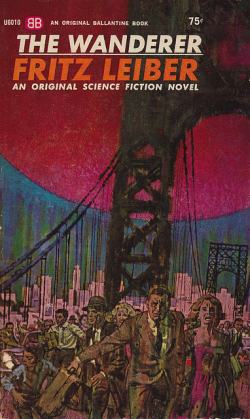
Janusz Andrzej Zajdel was a Polish science fiction author, second in popularity in Poland to Stanisław Lem. His major genres were social science fiction and dystopia. His main recurring theme involved the gloomy prospects for a space environment into which mankind carried totalitarian ideas and habits: Red Space Republics, or Space Labor Camps, or both. His heroes desperately try to find meaning in the world around them.

Space colonization is the process of establishing human settlements beyond Earth for prestige, commercial or strategic benefit, in contrast to space exploration for scientific benefit. Colonialism in this sense is multi-dimensional, including the exploitation of labor, resources and rights.

The Wanderer is a science fiction novel by American writer Fritz Leiber, published as a paperback original by Ballantine Books in 1964. It won the 1965 Hugo Award for Best Novel.
"The Menace From Earth" is a science fiction short story by American writer Robert A. Heinlein, first published in the August 1957 issue of The Magazine of Fantasy & Science Fiction.

Moon landing conspiracy theories claim that some or all elements of the Apollo program and the associated Moon landings were hoaxes staged by NASA, possibly with the aid of other organizations. The most notable claim of these conspiracy theories is that the six crewed landings (1969–1972) were faked and that twelve Apollo astronauts did not actually land on the Moon. Various groups and individuals have made claims since the mid-1970s that NASA and others knowingly misled the public into believing the landings happened, by manufacturing, tampering with, or destroying evidence including photos, telemetry tapes, radio and TV transmissions, and Moon rock samples.

A space settlement is a settlement in outer space, sustaining more extensively habitation facilities in space than a general space station or spacecraft. Possibly including closed ecological systems, its particular purpose is permanent habitation.

From the Earth to the Moon: A Direct Route in 97 Hours, 20 Minutes is an 1865 novel by Jules Verne. It tells the story of the Baltimore Gun Club, a post-American Civil War society of weapons enthusiasts, and their attempts to build an enormous Columbiad space gun and launch three people – the Gun Club's president, his Philadelphian armor-making rival, and a French poet – in a projectile with the goal of a Moon landing. Five years later, Verne wrote a sequel called Around the Moon.

Alfred Merrill Worden was an American test pilot, engineer and NASA astronaut who was command module pilot for the Apollo 15 lunar mission in 1971. One of 24 people to have flown to the Moon, he orbited it 74 times in the command module (CM) Endeavour.

The Garden of Rama is a 1991 novel by Gentry Lee and Arthur C. Clarke. It is the third book in the four-book Rama series: Rendezvous with Rama, Rama II, The Garden of Rama, and Rama Revealed, and follows on from where Rama II left off.

The colonization of Mars is the proposed process of establishing and maintaining control of Martian land for exploitation and the possible settlement of Mars. Most colonization concepts focus on settling, but colonization is a broader ethical concept, which international space law has limited, and national space programs have avoided, instead focusing on human mission to Mars for exploring the planet. The settlement of Mars would require the migration of humans to the planet, the establishment of a permanent human presence, and the exploitation of local resources.

Subterranean fiction is a subgenre of speculative fiction, science fiction, or fantasy which focuses on fictional underground settings, sometimes at the center of the Earth or otherwise deep below the surface. The genre is based on, and has in turn influenced, the Hollow Earth theory. The earliest works in the genre were Enlightenment-era philosophical or allegorical works, in which the underground setting was often largely incidental. In the late 19th century, however, more pseudoscientific or proto-science-fictional motifs gained prevalence. Common themes have included a depiction of the underground world as more primitive than the surface, either culturally, technologically or biologically, or in some combination thereof. The former cases usually see the setting used as a venue for sword-and-sorcery fiction, while the latter often features cryptids or creatures extinct on the surface, such as dinosaurs or archaic humans. A less frequent theme has the underground world much more technologically advanced than the surface one, typically either as the refugium of a lost civilization, or as a secret base for space aliens.
The Grand Tour is a series of novels written by American science fiction author Ben Bova.

Cosmo the Merry Martian was a comic book series published by Archie Comics between 1958 and 1959. The comic was created by Bob White as a way to provide a family-appropriate comic for children with an interest in the then-current space race. The title character was the first Martian to visit the Earth. The title only lasted for six issues. Every issue, including the last one, had a cliffhanger ending.

Ancient astronauts have been addressed frequently in science fiction and horror fiction. Occurrences in the genres include:

DARLAH is a 2008 young adult science fiction/horror novel by Norwegian author Johan Harstad. The book was originally published in Norway on September 15, 2008 by Cappelen Damm, with an English language translation being published by Little, Brown in New York City on July 10, 2012. Rights to DARLAH have also been sold to sixteen other countries: Denmark, Sweden, Finland, Iceland, Faroe Islands, France, the Netherlands, Germany, UK, Turkey, Bangladesh, Vietnam, Taiwan, South Korea, Mexico and Brazil. In 2008 Harstad's work on DARLAH won him a Brage Prize.

Space architecture is the theory and practice of designing and building inhabited environments in outer space. This mission statement for space architecture was developed in 2002 by participants in the 1st Space Architecture Symposium, organized at the World Space Congress in Houston, by the Aerospace Architecture Subcommittee, Design Engineering Technical Committee (DETC), American Institute of Aeronautics and Astronautics (AIAA).

Mars to Stay missions propose that astronauts sent to Mars for the first time should intend to remain there. Unused emergency return vehicles would be recycled into settlement construction as soon as the habitability of Mars becomes evident to the initial pioneers. Mars to Stay missions are advocated both to reduce cost and to ensure permanent settlement of Mars. Among many notable Mars to Stay advocates, former Apollo astronaut Buzz Aldrin has been particularly outspoken, suggesting in numerous forums "Forget the Moon, Let’s Head to Mars!" and, in June 2013, Aldrin promoted a crewed mission "to homestead Mars and become a two-planet species". In August 2015, Aldrin, in association with the Florida Institute of Technology, presented a "master plan", for NASA consideration, for astronauts, with a "tour of duty of ten years", to colonize Mars before the year 2040. The Mars Underground, Mars Homestead Project / Mars Foundation, Mars One, and Mars Artists Community advocacy groups and business organizations have also adopted Mars to Stay policy initiatives.

12 to the Moon is a 1960 independently made American black-and-white science fiction film, produced and written by Fred Gebhardt, directed by David Bradley and starring Ken Clark, Michi Kobi, Tom Conway and Anna-Lisa. The film was distributed in the U.S. by Columbia Pictures as a double feature with either Battle in Outer Space (1959) or 13 Ghosts (1960), depending on the local film market.
Zvi Lieberman was a Russian-born Israeli children’s book author. He immigrated to Palestine during the Second Aliyah period and helped to found Moshav Nahalal. His books became the basis for two landmark films in the history of Israeli cinema - "Oded the Wanderer" (1933) and "Over the Ruins" (1938).
















